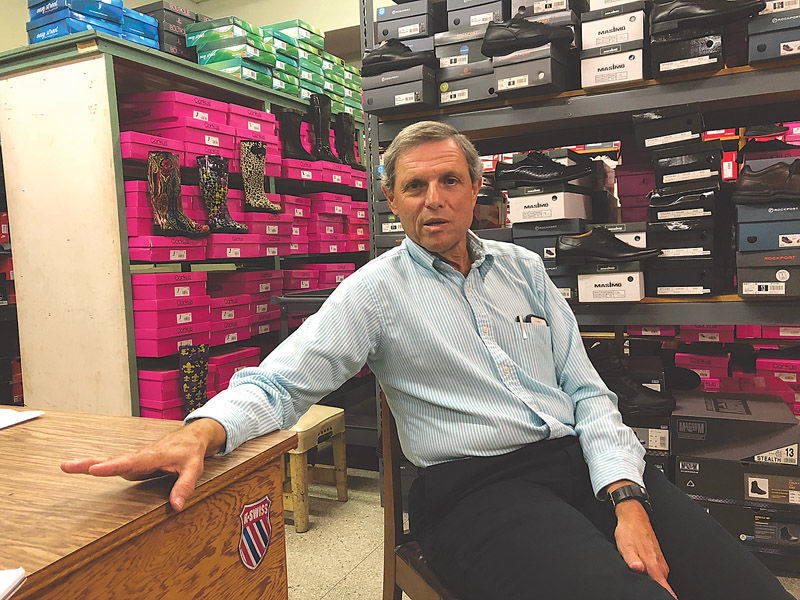Hometown Merchants
Published 8:07 pm Sunday, April 8, 2018

- Nostalgia washes over first time visitors to Meyer’s Shoe Store in Franklin as they remember days when shopping at independent shoe stores was common place rather than a novility. Henry Friedman, whose father Meyer Friedman purchased the current location in 1939, later tore down the existing two-story commerical space before building the current showroom store. A visit with him about merchandising gives insight into the challenges merchants now experience.
Their families built local communities
Trending
Walking into Meyer’s Shoe Store in downtown Franklin is like taking a step back in time — and in reality it is since the Friedman family has been merchants on Main Street since 1908. A front page ad on a replica of The Banner-Tribute dated April 29, 1959, reads, “A. Friedman & Son, 51 Years of Successful Merchandising in Franklin.”
The story within the ad tells their history which started when Abraham Friedman established The Franklin Racket Store. His great-grandson, Henry Friedman still operates the four generation business, one of two stores that served the community until downsizing several years ago. Henry Friedman will remain there with one employee until retirement, but he’s not ready yet.
“We had the department store across the street and my father bought this building in 1939 before he (later) went to fight in World War II,” Friedman said.
Henry Friedman only speculates now what the word “racket” meant at the time their stores began. They sold a mix of dry goods and general store merchandise, anything a thriving community might need.
In the remaining showroom business, the smell of leather lets you know you’re in a shoe store, a familiar feeling that is worth taking advantage of while it remains. Window shopping only peaks customer’s curiosity, but regular ones know why they are returning.
“We visit, we talk, we wait on them, I worry about selling shoes to someone having feet problems and even message them to check on how they are doing after they go home,” Sharon Caviess, a 35-year employee said. “I was born and raised here so everybody knows me. There may be a lot of styles in a brand, but if a doctor recommends them, they don’t tell you which one and there is a difference in shoes.”
Trending
Caviess said you have to know which style and price level to buy. Just because you pay $125 doesn’t mean they’re going to last a year or two. The inside wears out. If not replaced, you need new feet, knees and back.
“I can just look at people and know they’re walking around in bad shoes. I like to make sure my customers are satisfied with their shoes,” Caviess said. “They’re only getting one set of feet, knees and a back. You gotta make sure you take care of them. I don’t make commission. I want to tell you for your own good, you’ve got the wrong shoes.”
The Art of Selling Shoes
Customer service at Meyer’s Shoe Store includes Friedman and Caviess, both now experts in fitting shoes. Popularity of their brands and the generations of families coming in to shop have evolved into interstate commerce. Several costumers no longer live in the Teche Area, but even out-of-state customers call annually to order shoes — especially for their grandchildren.
Meyer’s has a lot of children’s shoes — the kind that support growing feet. Baby boomers can remember the days leading up to Easter Sunday when shopping for new shoes was a priority. Meyer’s still has one of the largest selections of tiny shoes in Acadiana. It’s a staple for their business.
“My mom brought me here, I brought (my children) here and now I’m buying for my grandchildren,” said Michele Chauvin, chief financial officer for the Civil Department of the St. Mary Parish Sheriff’s Office, better known as a generational customer. “You can come in, they’ll measure your foot, try on shoes and they’ll even let you take them on memo. I can get four or five pairs of shoes, take them home and let my husband try them on, bring back the ones he doesn’t want. He (Friedman) writes it in the book and if you never bring them back, he sends you a bill.”
After three generations shopping there, trust has been earned for this type of transaction. Emily Chauvin, 22, said because she has shopped there all of her life, Meyer’s is still her choice for buying shoes.
“Whatever’s in style, they’ll be sure to buy them for us,” said Emily Chauvin.
Michele Chauvin said Meyer’s carries uniform school shoes for the private schools as well. She and her daughter were stopping by to purchase new shoes for her 1-year-old and 3-year-old grandchildren. They live in St. Louis but she buys their shoes at Meyer’s in Franklin and mails them up there.
“We need to shop local and keep tax dollars here,” Chauvin said. “I see it in the sheriff’s office. Sales taxes are down, property taxes are down, so we need local shoppers.”
Tourists walk in and are amazed that a store like Meyer’s still exists to serve the needs of its customers.
Appreciation for the family merchant is never out of style, but with time, all things do change.
Buying Trends and Big Box Stores
Shopping in downtown America is changing. As much as local tourism and government entities preach “Shop Local,” some things about merchandising in small towns is beyond the control of anyone locally. A visit with Friedman paints a picture most advocates of living simple don’t like to here. Progress is changing the way consumers do business.
At 67, Friedman knows a day will come when his family legacy will end.
“In the old days, your suppliers were courting you and wanting you to do business with them. Now they don’t care. Not only that, some of them want to get rid of you because you’re too small. It’s one of the big challenges we face. They don’t want to be bothered,” he said.
Major brands want to sell 100,000 pairs of shoes not small quantities, he said. They now make their products available through business to business websites and don’t even come to the stores. At one time the sales reps would line up to show their wares to owners. Now, according to Friedman, Nike wants to do business with 40 accounts worldwide and are planning to close accounts with independent outlets. Those select customers may have more than 1,000 stores each. Nike will cut out the independents and they plan to sell directly to customers through internet sales.
That attitude coupled with the cost of keeping a sales rep on the road also has played into the reduction of product distribution made face to face. Shows are now fewer in number and in the biggest cities. Most product lines are there, but the expense is prohibitive for small retailers to attend.
“This (storefront) is not going to exist in five to ten years, I’ll try to sell the business, but who knows if I’ll be able to not just due to vendors, but because of the increase of online shopping,” Friedman said.
End of the Line
The father of five children said he is happy to see his children succeeding with their gifts and talents, but without another generation interested in sustaining a dying breed — merchants — an end to an era must be bittersweet. Friedman said he never expected his children to follow in his footsteps, but without their interest and the fact retail has changed so much since the days of his ancestors, there would be no reason to pass it on — but he is confident the retail store will be missed.
“I never really planned on (being in retail), I wasn’t sure what I was going to do. I got married and moved to Dallas. My father, who died in 1979, needed my help, we made a decision. We moved back and I started helping him. When the door closes a new door opens,” he said. “I like supporting my town. I’ve seen everything and done everything. Things have turned 180 degrees.”
Behind the Storefront
The comments Friedman shared about the future of small town retailer experience have more to do with global merchandising than the local customer base.
What customers will not find on line, and something Meyer’s provides its customers, is the knowledge of how to fit a shoe or help someone with foot problems to find the right shoe.
“I know about shoes and how to fit people with certain problems. That’s why people come here. Basically, if they have a problem, we know what kind of shoe to put them in,” Friedman said. “You can wear this one and hurt, or you can wear this one and feel better.”
Merchants once built the country by providing the goods pioneers needed to sustain their families. They built homes and businesses, built community. Now it’s time for the community to support the local merchants that still find customer service the reason to exist — for as long as they are able to survive.

